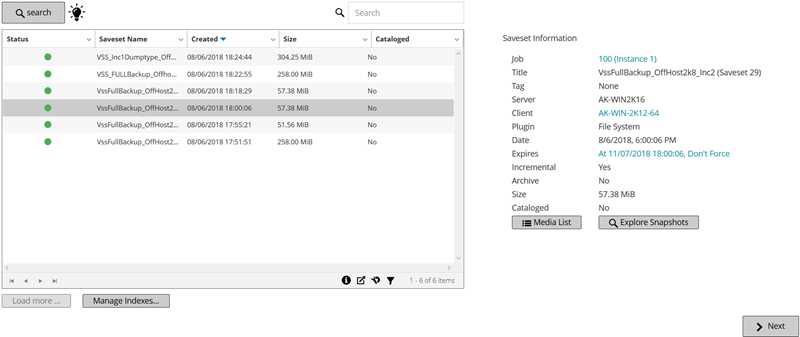Deleting a backup policy
If a backup policy is no longer required, you can delete it from the database.
|
1 |
In the Navigation pane, click Manage Policies. |
|
2 |
Restoring data
About restoring data
Restore refers to reconstructing all or part of a system from a backup.
You can perform a restore job for various reasons, such as the following:
In general, NetVault Backup offers the following restore features:
To restore data, you need to create and submit a restore job. You can create a restore job definition from the Create Restore Job link in the Navigation pane.
A restore job definition includes the following components:
These components are stored in NetVault Backup Sets. For more information about NetVault Backup Sets, see About NetVault Backup Sets.
Creating restore jobs
You can use the restore job wizard to create and submit restore jobs. The wizard can be accessed from the Create Restore Job link in the Navigation pane.
|
1 |
In the Navigation pane, click Create Restore Job. |
|
2 |
The Create Restore Job — Choose Saveset page loads a maximum of 5000 records initially. The total number of records fetched is displayed at the lower-right corner of the table. |
|
NOTE: If the online backup index is unavailable for the selected saveset, the Confirm load dialog box is displayed. To load the index from the backup media, click OK, and then in the Load Index dialog box, type or select the number of days you want to store the index in the NetVault Database. |
|
4 |
On the Create Selection Set page, select the items that you want to restore. |
|
5 |
Click Edit Plugin Options, and configure the options that you want to use. |
|
6 |
On the Create Restore Job page, specify a name for the job. Assign a descriptive name that allows you to easily identify the job for monitoring its progress. |
|
7 |
In the Target Client list, select the restore target. To restore data to the same client (from which data was backed up), use the default setting. |
|
8 |
In the Schedule list, select an existing Schedule Set, or click Create New, and configure the schedule type and schedule method. For more information. For more information, see Creating Schedule Sets. |
|
9 |
In the Source Options list, select an existing Source Set, or click Create New, and configure the source device options. For more information, see Creating Source Sets for restore jobs. |
|
10 |
In the Advanced Options list, select an existing Restore Advanced Options Set, or click Create New, and configure the options that you want to use. For more information, see Creating Restore Advanced Options Sets. |
|
11 |
Click Submit to submit the job for scheduling. |

